|
|
| |
|
|
| |
|
|
|
|
| |
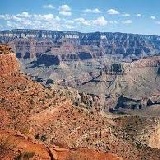 Travel
America Travel
America
Learn before you travel. This section of Fun Easy
English focuses on facts and other cool stuff about
your favorite U.S. state. This is great English
reading practice. This page focuses on the state of
Hawaii. |
 Hey
if you cannot understand something on this page, Hey
if you cannot understand something on this page,
then use the Fun Easy English
dictionary
(opens in a new window) |
|
|
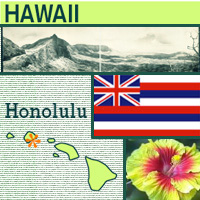 Hawaii Hawaii
Known as the "Aloha State" (in Hawaiian, "aloha" can
mean "hello"), Hawaii is a group of volcanic islands
in the central Pacific Ocean that together became
the 50th state in 1959. The state's name is possibly
derived from a native Hawaiian word for homeland,
hawaiki or owhyhee. Today, Hawaii, whose capital is
Honolulu, is often called the "Crossroads of the
Pacific" and is a popular vacation spot. The
colorful hibiscus is the state flower. |
|
Hawaii
State Flag
The flag of Hawai'i resembles the Union Jack of
Great Britain because many of King Kamehameha's advisors
were British and the islands were once placed under
England's protection.
Eight horizontal stripes represent the eight major islands
of Hawai'i. This flag has served as the flag of the kingdom,
republic, territory, and the state of Hawai'i. |
|
Source:
State Symbols USA |
|
|
 Hawaii
State Facts Hawaii
State Facts
Picture: state seal of Hawaii |
|
State Capital |
Honolulu |
|
Nickname |
Aloha State / Paradise of the Pacific |
|
Motto |
Ua mau ke ea o ka aina I ka pono (The life of the
land is perpetuated in righteousness.) |
|
Statehood |
August 21, 1959 (50th) |
|
Origin of Name |
Possibly based on native Hawaiian word for homeland,
"Owhyhee." |
|
Largest Cities |
Honolulu, Hilo, Kailua, Kaneohe, Pearl City |
|
Border States |
None |
|
Area |
6,423 sq. mi.; 47th largest |
|
State Bird |
Nene (Hawaiian goose) |
|
State Flower |
Pua Aloalo (hibiscus brackenridgei) |
|
State Tree |
Kukui - Candlenut (aleurites moluccana) |
|
State Song |
Hawaii Ponoi - Hawaii's Own |
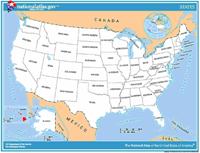 Travel and tourism site
for Hawaii - This state travel and territorial tourism
site provides ideas for your vacations, meetings, and more. Travel and tourism site
for Hawaii - This state travel and territorial tourism
site provides ideas for your vacations, meetings, and more. |
|
|
Hawaii Stories |
|
|
King Kamehameha Celebration
Did you know that a long line of monarchs once ruled Hawaii? King
Kamehameha I was one member of this royal line. He was born in North
Kohala on the island of Hawaii, and it's estimated that he was born
between 1748 and 1761. His childhood was spent in seclusion with
foster parents who trained him in the skills of warfare and prepared
him for his role as warrior-king of the island nation.
Although Kamehameha lived at the same time as Napoleon and George
Washington, they were very different kinds of rulers, mainly because
of how different their cultures were. During King Kamehameha I's
reign, there was no written language, and the Polynesian religion
that was practiced was called Hoomana. This religion was based on a
group of gods similar to those of the Romans and Greeks.
Kamehameha I was a very successful king and ruled in peace. He
accomplished a great deal by establishing trade with foreign
countries, introducing new animal and plant life, and promoting
agriculture and industry.
King Kamehameha I died in 1819. Today, every June 11, the giant
statue of King Kamehameha shown here is decorated and festivities
include parades on every island, arts and crafts fairs, sports
challenges, pageantry, and an international hula competition. |
|
|
Okinawan Festival
Can you guess where this young Taiko performer might get some andagi,
ashitibichi, and yaki soba?
If you guessed Japan, you're close! Many Japanese people (over
125,000) moved from Japan to Hawaii in search of a better life.
They, along with other Asian immigrants, were often employed to work
on sugar plantations. Today, there is a strong Japanese culture in
Hawaii and it is celebrated with the Okinawan Festival. So, if
you're eating andagi you're eating deep-fried doughnuts, if you're
eating ashitibichi, you're eating pig's feet soup, and if you're
eating yaki soba you're eating noodles stir-fried with vegetables
and meat. These are all delicious Okinawan-style dishes that you can
try at the festival held each year at Kapiolani Park in the middle
of Waikiki.
Along with traditional Okinawan dishes, visitors can experience all
kinds of traditional Okinawan culture and arts. The festival
includes a parade with a paranku procession. A paranku is a small
hand-held drum used in folk performing art called eisa. Other
traditional Okinawan musical instruments include the taiko (drum),
sanshin (lute) and the koto (zither). Have you ever seen any of
these instruments? There is also the Obon, a dance performed by
large groups of men, women and children of all ages. |
|
|
Hawaiian Canoe
Have you ever been in a canoe? Can you imagine traveling across the
ocean in one? When Captain James Cook asked, "How shall we account
for this nation having spread itself to so many detached islands so
widely disjoined from each other in every quarter of the Pacific
Ocean?" as early as the 18th century, he was wondering specifically
about the Polynesian people. How did they get to so many islands
spread so far apart? Perhaps the answer lies in the Hawaiian canoe.
Canoes served several purposes for early Hawaiians. Can you guess
what some of them might be? Smaller canoes were used for traveling
around the islands, while larger canoes were used for long-distance
traveling or warfare. Fishing was also done from canoes. And, just
like today, canoes were used for sports and recreation.
Hawaiian canoes were made of acacia koa, a tree that is now very
scarce. Canoes were historically built by master craftsmen who
oversaw all aspects of the process, from selecting the trees to
getting the boat into the water. Lashing, or binding, of the pieces
of wood was done with coconut or vegetable fiber. |
|
|
Ching Ming Tradition in Hawaii
How do you honor your ancestors? If you were Chinese, you might
celebrate Ching Ming.
Dating back 3,000 years, the practice of Ching Ming is still
observed worldwide by Chinese families. Ching means "pure" or
"clean"; ming means "brightness." The words together are applied to
a Chinese tradition that helps explain why respect for elders is
such an important part of the Chinese culture. Many Chinese believe
that a person's good fortune or misfortune comes from his or her
ancestors; that all departed ancestors still have the same physical
needs they had when alive; and that the departed can assist their
relatives on Earth.
Today, Ching Ming is celebrated every April 4 in Hawaii and involves
the cleaning, repairing and replanting of ancestral gravesites. In
Hawaii, the practice has a stronger presence than in other parts of
the United States. Ceremonies involve preparing foods as a symbol of
earthly possessions and laying them out on the grave. These foods
may include fruit, rice, chicken, pork, cakes and tea. A meal may be
eaten at the gravesite as a gesture of sharing with deceased
relatives. Other customs include burning incense, offering prayers
and burning symbolic paper. It is not necessarily a time of sadness,
but one of reflection, remembrance and communion with past
generations. |
|
|
Portuguese Holy Ghost Festival and
Traditional Practices
Portuguese immigrants first came to Hawaii in the late 1800s to work
in the sugar cane fields. They brought their culture with them, and
since 1901, the Feast of the Holy Ghost has been celebrated in
Hawaii. This feast originated centuries ago with the sixth Queen of
Portugal, Isabel. It is a Catholic celebration that proclaims the
faith of the Portuguese and their devotion to the Holy Ghost, the
member of the Holy Trinity now referred to as the Holy Spirit.
For each of the seven Saturdays leading up to the feast, known as
Domingas, a different historical or religious figure is honored. The
highlight of the entire event is a three-day festival that begins on
the Friday night just before the Seventh Dominga, the "Blessing of
the Meat and Bread," in which a portion of beef and bread -- the "Pensao"
-- is blessed by a priest and distributed to each member present.
Following the tradition of charity and feeding the poor, a bowl of
soup or stew is served to everyone. On Saturday night, participants
decorate religious statues in preparation for the Sunday Mass. A
woman is chosen to represent Queen Isabel, and she and her court
join a procession. At the end of the Mass, the priest crowns the
Holy Ghost Queen. |
|
|
Prince Lot Hula Festival
Did you know that you can tell stories with a dance? That's what the
kids in the photo are doing when they do the hula, a traditional
dance of Hawaii. The hula combines flowing movement with facial
expressions, all set to special chants and music. When hula began it
was a form of worship.
Prince Lot Kapu`aiwa kept the hula alive in Hawaii at a time when
interest in it was fading. Can you guess how he did it? The prince,
who later became Kamehameha V, King of Hawaii from 1863 to 1872, was
noted for his energy and strength of will. One of his interests was
to promote and preserve Hawaiian culture, especially the hula. He
did this by holding hula performances at his cottage in Moanalua. To
many, the hula represents Hawaiians' view of the world.
In appreciation of Prince Lot's efforts to preserve Hawaiian
culture, the Prince Lot Hula Festival was established in 1978. Each
year na halau (hula schools) come to the festival to perform at
Moanalua Gardens in Honolulu. This festival also includes other
Hawaiian activities and exhibits such as hand-stitched quilts,
leaf-weaving demonstrations to make hats and baskets,
instrument-making and lei-making (a lei is a necklace of flowers). |
|
|
Even Royalty Surfs in Hawaii
Did you know that in Hawaii's early days, when it was ruled by
royalty, even kings and queens surfed?
Surfing is considered part of modern American pop culture, but the
sport actually developed centuries ago in Polynesia in the Pacific
Ocean. It was later brought to Hawaii in the eighth century.
Petroglyphs (rock paintings) have been found in Hawaii that show
early Hawaiians riding the waves. British explorer Captain James
Cook made the first mention of surfing in print in his account of
his journey through the Pacific Ocean. Even the early kings and
queens of Hawaii participated in the sport. American writers Mark
Twain and Jack London are known to have tried surfing. Duke
Kahanamoku, who was born in Hawaii, was a gold medalist in swimming
at the 1912 Olympic Games. He is commonly credited with the rise in
popularity of surfing in the 20th century. |
|
Source:
Library of Congress |
|
 National
Parks and Monuments of Hawaii National
Parks and Monuments of Hawaii
The following is a description of national
parks and monuments in the state
of Hawaii. There are no national forests in
this state. If you plan to visit or live in
Hawaii for awhile then you should definitely
plan to visit some of these fantastic
places. |
|
|
|
National Parks |
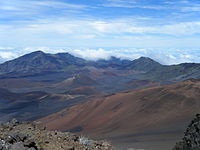 Haleakalā Haleakalā
The Haleakalā volcano on Maui features a
very large crater with numerous cinder
cones, Hosmer's Grove of alien trees, the
Kipahulu section's scenic pools of
freshwater fish, and the native Hawaiian
goose. The park protects the greatest number
of endangered species within a U.S. National
Park. |
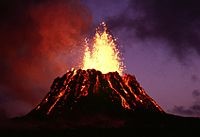 Hawaiʻi
Volcanoes Hawaiʻi
Volcanoes
This park on the Big Island protects the
Kīlauea and Mauna Loa volcanoes, two of the
world's most active geological features.
Diverse ecosystems range from tropical
forests at sea level to barren lava beds at
more than 13,000 feet (4,000 m). |
|
|
|
National Monuments |
 Honouliuli Honouliuli
Comprises the grounds of the Honouliuli
Internment Camp on the island of Oahu. It
was the largest and longest-operating
facility used for Japanese American
internment in the United States. |
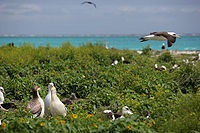 Papahānaumokuākea
Marine Papahānaumokuākea
Marine
The marine monument consists of ocean waters
and 10 islands and atolls of the
Northwestern Hawaiian Islands including
Midway Atoll (which is the site of the
Midway Atoll National Wildlife Refuge). The
monument was created in 2006 with 139,797
square miles (362,070 km2), and its
boundaries were expanded on August 26, 2016,
more than quadrupling in size to a total
area of 582,578 square miles (1,508,870
km2). It is the largest protected area on
Earth, and is almost the size of the Gulf of
Mexico. The Northwestern Hawaiian Islands
archipelago "is the planet's largest seabird
gathering site, with more than 14 million
birds from 22 species, and is home to nearly
all Laysan albatrosses and the remaining
endangered Hawaiian monk seals." It was
declared a World Heritage Site in 2010. |
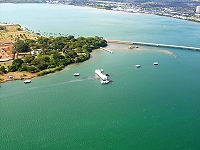 World
War II Valor in the Pacific World
War II Valor in the Pacific
Valor in the Pacific encompasses nine sites
in three states associated with World War
II: The Attack on Pearl Harbor, including
the USS Arizona, Utah, and Oklahoma
memorials in Hawaii; the Aleutian Islands
Campaign on Attu Island, Kiska Island, and
Atka Island in Alaska; and the Japanese
American internment at Tule Lake War
Relocation Center in California. This
national monument is also partially located
in the state of Alaska and California. |
|
|
|
|
|
|
|
|
|
|
|
|
Cool America |
 About the U.S.A. About the U.S.A.
About the U.S.A. is an American
Studies reader that examines the customs, government, and history of the
United States of America. The text provides a wealth of information on U.S.
geography and history; the roles of local, state, and federal government;
national holidays and symbols; the Constitution; and citizenship. The book,
which was written for intermediate to advanced learners of English, contains
a range of activities for language students to practice listening, speaking,
reading, and writing. (opens to a new PDF window)
Great English reading
practice. |
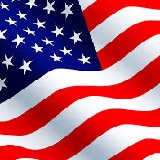 About
America About
America
Learn about the fascinating history and government of
the United States of America. Lessons include content on
American Government, American History, and Integrated
Civics. Handouts with interactive games and
student-centered activities encompass all four language
skills: speaking, listening, reading, and writing.
Great English reading practice for
beginning to intermediate students. |
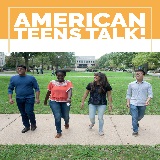 American Teens Talk! American Teens Talk!
Americans Teens Talk! is a collection of interviews of
American high school students. Each interview is accompanied by vocabulary
notes and discussion questions. The interviews in American Teens Talk! give
learners a view into the lives of adolescents in the U.S. Through the
written format of the interviews, learners are able to increase their
vocabulary, practice their reading and listening skills, engage in
discussions, and learn more about U.S. culture. These
interviews come with audio programs.
Great English listening and
reading |
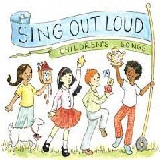 Sing Out Loud Children's Songs Sing Out Loud Children's Songs
Sing Out Loud Children's Songs includes popular children's songs in the U.S.A. Posters accompany the
individual Sing Out Loud Children's Songs. These
songs come with audio programs.
Great English listening and reading
practice. |
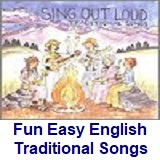 Sing Out Loud Traditional Songs Sing Out Loud Traditional Songs
The Sing Out Loud Traditional Songs
collection contains 13 traditional American folk songs and song lyrics.
Listen to the songs online, read the lyrics, and collect the posters that
accompany the songs. These
songs come with audio programs.
Great English listening and reading
practice. |
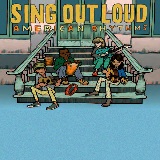 Sing Out Loud American Rhythms Sing Out Loud American Rhythms
Do you love music? Want to use it
to learn English? Check out the hip-hop inspired song "Peace" from Sing Out
Loud American Rhythms. American Rhythms includes a variety of musical genres
from many different artists in the U.S.A. These songs will appeal to teens
and young adults. These
songs come with audio programs.
Great English listening and reading
practice. |
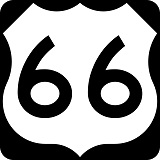 Route
66 - Famous American Road Route
66 - Famous American Road
U.S. Route 66 (US 66 or Route 66), also known as the Will Rogers Highway, the
Main Street of America or the Mother Road, was one of the original highways in
the U.S. Highway System. The highway, which became one of the most famous roads
in the United States, originally ran from Chicago, Illinois, through Missouri,
Kansas, Oklahoma, Texas, New Mexico, and Arizona before ending in Santa Monica,
California, near Los Angeles, covering a total of 2,448 miles (3,940 km). It was
recognized in popular culture by both the hit song "(Get Your Kicks on) Route
66" and the Route 66 television show in the 1960s. |
Route 66: The Highway That's the Best
(Beginner - Listening)
A video lesson which shows you an interesting place in America.
The English is
spoken at 75% of normal speed.
Great English listening practice.
This video shows travel along Route 66, the most famous road in
America. |
Chicago: The Start of Route 66
(Beginner - Listening)
A video lesson which shows you an interesting place in America.
The English is
spoken at 75% of normal speed.
Great English listening practice.
This video shows travel along Route 66, the most famous road in
America. |
Going West for Decades on Route 66
(Beginner - Listening)
A video lesson which shows you an interesting place in America.
The English is
spoken at 75% of normal speed.
Great English listening practice.
This video shows travel along Route 66, the most famous road in
America. |
Arizona: The Spirit of Route 66
(Beginner - Listening)
A video lesson which shows you an interesting place in America.
The English is
spoken at 75% of normal speed.
Great English listening practice.
This video shows travel along Route 66, the most famous road in
America. |
Route 66 California: The End of the Trail
(Beginner - Listening)
A video lesson which shows you an interesting place in America.
The English is
spoken at 75% of normal speed.
Great English listening practice.
This video shows travel along Route 66, the most famous road in
America. |
Ten Must-See Route 66 Attractions
(Beginner - Listening)
A video lesson which shows you an interesting place in America.
The English is
spoken at 75% of normal speed.
Great English listening practice.
This video shows travel along Route 66, the most famous road in
America. |
Four Famous Foods On Route 66
(Beginner - Listening)
A video lesson which shows you an interesting place in America.
The English is
spoken at 75% of normal speed.
Great English listening practice.
This video shows travel along Route 66, the most famous road in
America. |
International Tourists Drawn to Route 66
(Beginner - Listening)
A video lesson which shows you an interesting place in America.
The English is
spoken at 75% of normal speed.
Great English listening practice.
This video shows travel along Route 66, the most famous road in
America. |
|
|
|
|
Search Fun Easy English |
|
|
|
|
|
|
|
|
|
|
|
|
|
|
|
About
Contact
Copyright
Resources
Site Map |